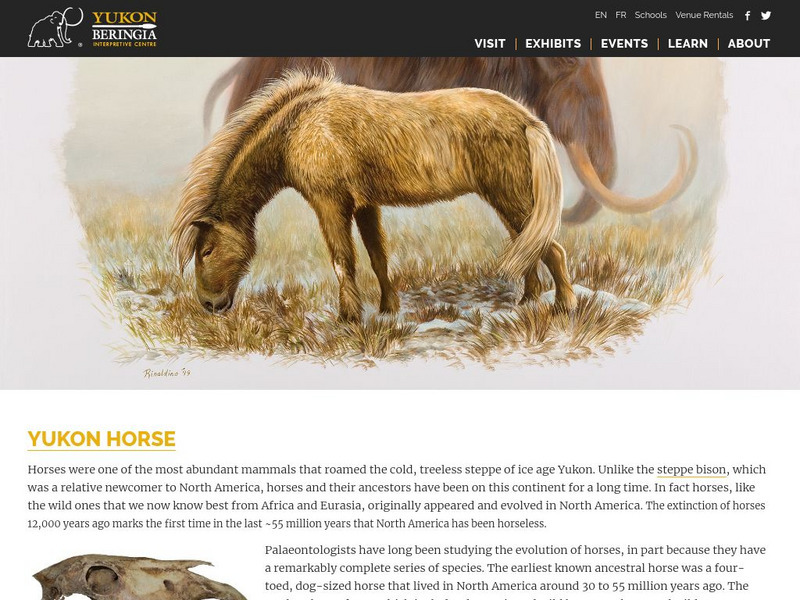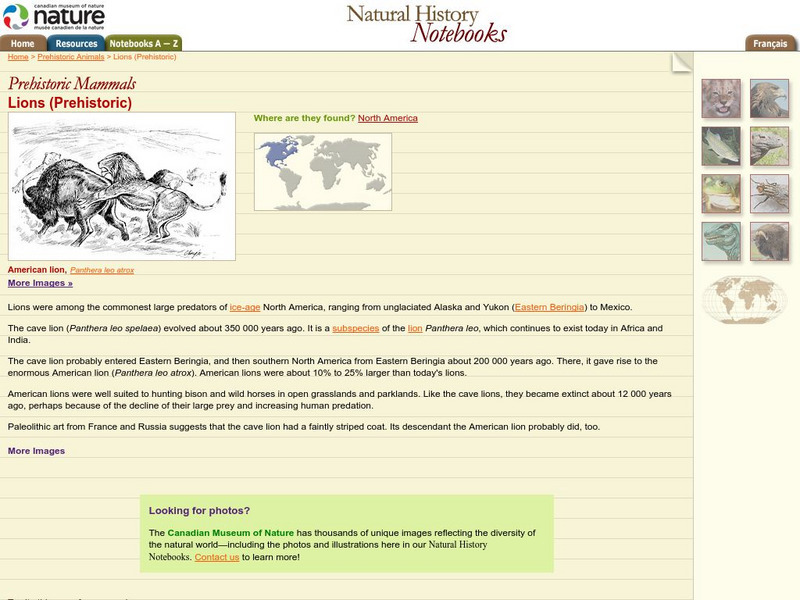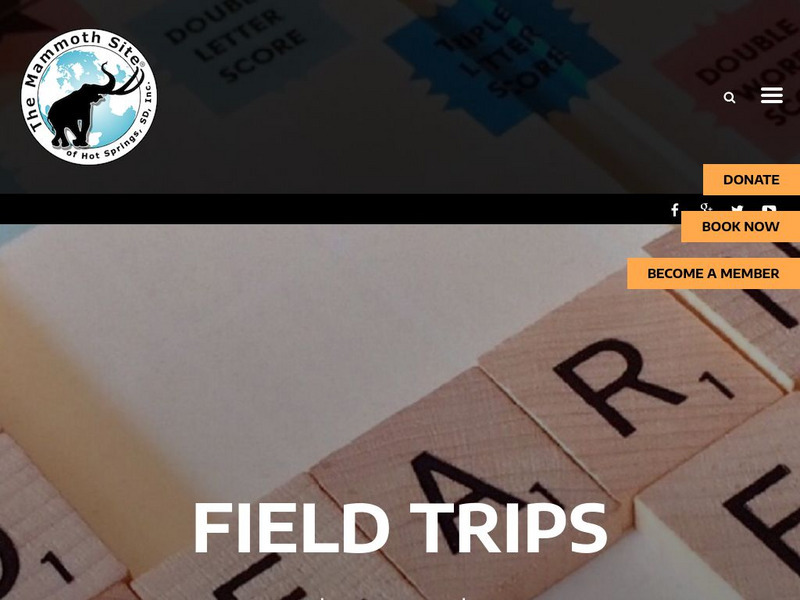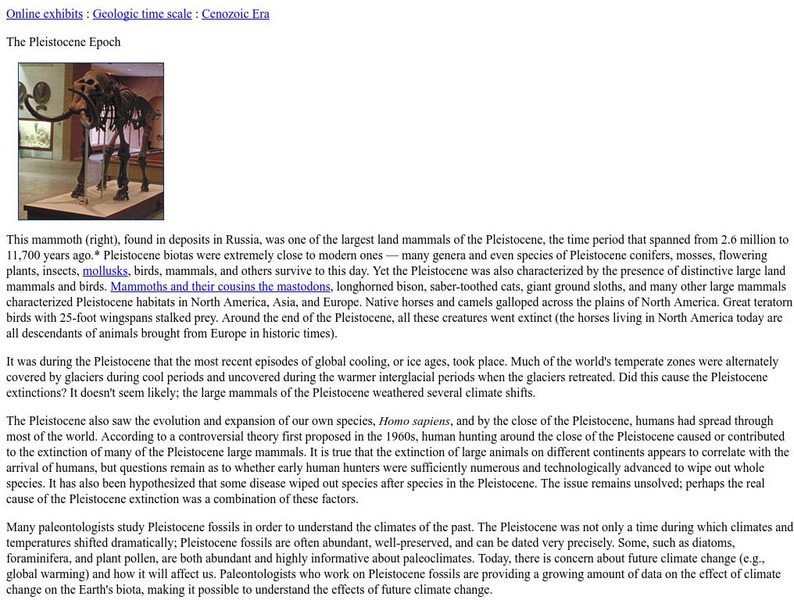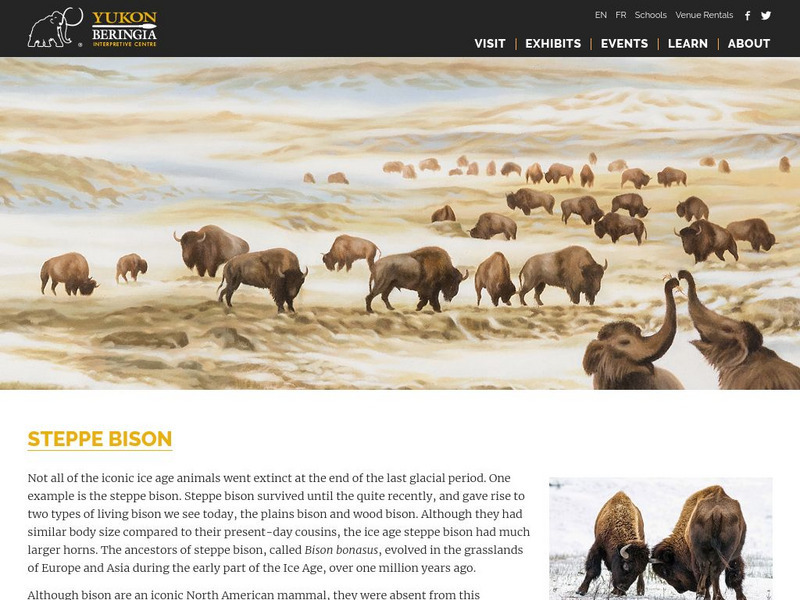Canadian Museum of Nature
Canadian Museum of Nature: Woolly Mammoth
A short but very interesting description of the Woolly Mammoth; its habitat and habits are described.
Other
Yukon Beringia Interpretive Centre: Research: Yukon's Camels
Uncover discoveries from the past by learning about the prehistoric camels of the Yukon and Alaska. Includes information about the time period, physical characteristics, fossil specimens, feeding habits, and habitat.
Other
Yukon Beringia Interpretive Centre: Research: Yukon Horse
Uncover discoveries from the past by learning about the prehistoric Yukon horse. Includes information about the time period, physical characteristics, fossil specimens, feeding habits, and habitat.
Other
Yukon Beringia Interpretive Centre: Research: Saiga Antelope
Uncover discoveries from the past by learning about the prehistoric North American saiga. Includes information about the time period, physical characteristics, fossil specimens, feeding habits, and habitat.
Other
Yukon Beringia Interpretive Centre: Research: Jefferson's Ground Sloth
Uncover discoveries from the past by learning about the prehistoric Jefferson's ground sloth. Includes information about the time period, physical characteristics, fossil specimens, feeding habits, and habitat.
Other
Yukon Beringia Interpretive Centre: Research: American Mastadon
Uncover discoveries from the past by learning about the prehistoric American mastodon. Includes information about the time period, physical characteristics, fossil specimens, feeding habits, and habitat.
Other
Yukon Beringia Interpretive Centre: Research: North American Scimitar Cat
Uncover discoveries from the past by learning about the prehistoric North American scimitar cat. Includes information about the time period, physical characteristics, fossil specimens, feeding habits, and habitat.
Other
Yukon Beringia Interpretive Centre: Research: Giant Beaver
Uncover discoveries from the past by learning about the prehistoric giant beaver. Includes information about the time period, physical characteristics, fossil specimens, feeding habits, and habitat.
Other
Yukon Beringia Interpretive Centre: Research: Beringian Lion
Uncover discoveries from the past by learning about the prehistoric Beringian lion and the American lion that evolved from it. Includes information about the time period, physical characteristics, fossil specimens, feeding habits, and...
Canadian Museum of Nature
Canadian Museum of Nature: Lions (Prehistoric)
Lions were among the largest predators during the ice age. Get other interesting facts about this ancestor of the American Lion.
Other
Mammoth Site Geology
This is the website for The Mammoth Site in Hot Springs, South Dakota. The Mammoth Site boasts the largest concentration of mammoths in the world. You can tour this indoor active dig site and view Ice Age fossils. The site offers a video...
Other
Yukon Beringia Interpretive Centre: Research: Giant Short Faced Bear
Uncover discoveries from the past by learning about the prehistoric giant short-faced bear. Includes information about the time period, physical characteristics, fossil specimens, feeding habits, and habitat.
Other
Yukon Beringia Interpretive Centre: Research: Helmeted Muskox
Uncover discoveries from the past by learning about the prehistoric helmeted muskox. Includes information about the time period, physical characteristics, fossil specimens, feeding habits, and habitat.
University of California
Ucmp: The Pleistocene
The UCMP Berkeley provides a brief overview of the Pleistocene Era, including links to more information.
University of Illinois
University of Illinois Extension: Animals Past and Present
In English and Spanish this site deals with animal life in Illinois past and present. With sections on dinosaurs, animals in Illinois 65 million years ago, animals in Illinois 10 million years ago, and animals in Illinois today, this is...
Other
Yukon Beringia Interpretive Centre: Research: Steppe Bison
Uncover discoveries from the past by learning about the prehistoric steppe bison. Includes information about the time period, physical characteristics, fossil specimens, feeding habits, and habitat.


